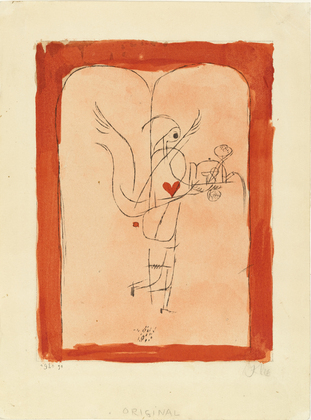
Art and Devastation: A Tour of German Post-War Expressionism #6
Paul Klee, A Guardian Angel Serves a Small Breakfast, 1920. Lithograph with watercolor. MoMA.
Klee maintained a personal mysticism all his life. He followed no system. In his works, he located the life-giving center in the navel. He said in his 1924 Jena lecture that the artist’s job is to penetrate “toward that secret place where the primeval power nurtures all evolution.”
That axiom is on display in this spare drawing. The angel is formed by intersecting curved lines, which keep the eye traveling around the image. Red is the only color: the painted frame, the heart, and the red dot under the wing. That dot is balanced by the black one that forms the angel’s eye. This image is a window for meditation, a prompt to participate in what Klee believes is a life-giving process.
Here is a coherent offer of hope through an image. But can a picture save a soul from the devastation of war?
